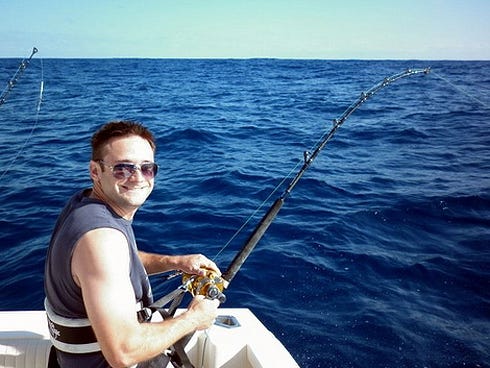
Sailfish hold a special place in many Florida resident and visitor’s hearts. Whether they’ve admired a replica of the beautiful fish while waiting for a fresh-caught meal at a local restaurant, or felt their blood pump as one leapt into the air on the other end of a fishing line, the fish known for its tall “sail-like” dorsal fin is a Florida icon.
Though you can find the highly migratory species in warm offshore waters around the globe, sailfish are so abundant off the coast of Florida and so popular with people it was made the state’s official saltwater fish in 1975.
Between its aesthetic beauty and its penchant for fighting, sailfish are a recreational favorite.
Like bonefish or tarpon, two of Florida’s other iconic fishes, the sailfish has a higher value as a recreational catch-and-release species than it does as a commercial food fish. The meat is tough and is rarely eaten unless smoked.
I sat down with coworker, Florida Fish and Wildlife Conservation Commission biologist and sailfish fan Justin Lerner to find out a little more about the appeal of fishing for sailfish.
“It’s very exciting fishing, especially when using a kite,” Lerner said, describing a fishing method where an actual kite is used to dangle bait at the top of the water, enticing the sailfish to take the bait right before your eyes. “It is a very fast, very acrobatic fish with a lot of energy.”
Lerner caught his first sailfish in 2000 on an offshore charter trip and was instantly hooked (my apologies for the pun).
While they are typically caught in water 80 to 240 feet deep, sailfish, unlike other billfish, can be found in fairly shallow water and, though not common, have even been caught off piers in south Florida and in the northern Gulf of Mexico near Panama City.
Look for color changes in the water, Lerner said, and fish along them. When the water goes from an inshore green to a deep blue you are in the right spot.
Sailfish can be caught in every region of Florida, but they are more abundant in south Florida in the colder months, from October through March.
“Cold fronts drive bait south, and fish run an interception,” Lerner said.
In areas of north Florida and the Panhandle, such as Panama City, they are more abundant during the summer and fall months.
Sailfish have been regulated in state waters at least since 1988, when a possession limit of one billfish per person was implemented, sale was prohibited, and gear was restricted to hook and line.
Today, there is a recreational bag limit of one billfish per person. Billfish includes blue marlin, white marlin, roundscale spearfish and sailfish. This means you can catch and keep one only billfish species per person, per day. There is no daily bag limit in federal waters for sailfish.
When fishing in federal waters, a federal Highly Migratory Species angling permit is required. Federal waters are beyond 3 nautical miles in the Atlantic and beyond 9 nautical miles in the Gulf.
While technique varies, one of the most popular ways to catch them is by kite fishing with live bait, usually goggle eyes or blue runners. Other popular techniques are slow trolling with live ballyhoo, or trolling with hookless bait and teasers and casting to fish as they appear in the trolling spread. Other popular live baits are threadfin herring and pilchards.
Hooked a sailfish? Once you get your fish to the boat, use caution. The long and pointed bill can be dangerous when attempting to unhook the fish. Lerner suggests holding the fish in the water by the bill while unhooking. Another option is cutting the line as close to the fish as possible. When release is your intention, leave the fish in the water at all times. Removing large fish from the water can cause internal damage to the fish and decrease its chances of survival. In all federal waters off Florida, a sailfish must remain in the water if you intend to release it.
While the species fights hard, it can tire and may need to be revived if you plan on releasing the fish. Use the appropriate tackle to shorten the amount of time it takes to bring your catch to your vessel. You can revive a sailfish by pointing its head into the current or pulling the fish through the current while the boat is moving slowly. This pushes water over the gills.
While most sailfish are caught and then released, if you plan on keeping yours, the sailfish caught in state or federal waters must be larger than 63 inches when measured from the end of the lower jaw to where the tail splits, also known as the fork.
Sailfish do not have a recreational closed season in state or federal waters.
All sailfish and other billfish caught in state and federal waters that are taken to shore or landed must be reported to National Oceanic and Atmospheric Administration Fisheries with 24 hours by calling 800-894-5528 or visiting the HMS permits website's Landing Reports page.
Learn more about billfish, including sailfish at the FWC's Highly Migratory Species webpage.
Have questions, comments or suggestions for this column? Email them to Saltwater@MyFWC.com.
Gone Coastal is one of many ways that the Florida Fish and Wildlife Conservation Commission Division of Marine Fisheries Management is helping recreational anglers understand complex saltwater regulations and learn more about saltwater fishing opportunities and issues in Florida. To contact the FWC’s Regulatory Outreach subsection call 850-487-0554 or email the above address.
This article originally appeared on Crestview News Bulletin: GONE COASTAL: Florida's sailfish offers on-the-water excitement
